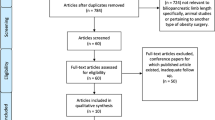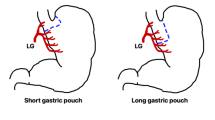Abstract
Bariatric surgery is an effective long-term treatment for patients who suffer from morbid obesity, the incidence of which is increasing in North America. Laparoscopic gastric bypass and laparoscopic adjustable gastric band placement are the two commonly performed bariatric procedures. This article discusses the indications for bariatric surgery and the early and late complications associated with these two procedures. Laparoscopic biliopancreatic diversion and laparoscopic sleeve gastrectomy are also briefly discussed.
Key Points
-
Bariatric surgery is an effective long-term treatment for morbidly obese patients (i.e. a BMI >40 mg/kg2) who have failed nonsurgical attempts to lose weight
-
At present, the two bariatric operations most commonly performed are laparoscopic gastric bypass and laparoscopic adjustable silicone gastric band placement
-
Complications of laparoscopic Roux-en-Y gastric bypass include anastomotic leak, bowel obstruction, gastrointestinal hemorrhage, wound infection, pulmonary embolism, anastomotic stricture, incisional hernia, and marginal ulceration
-
Complications of laparoscopic adjustable silicone gastric band placement include gastric perforation, stoma obstruction, band slippage, access port infection, port and tubing problems, and band erosion
-
Complications occur infrequently when surgery is performed by experienced surgeons who work in centers with the necessary equipment and personnel
-
Until there have been prospective, randomized trials to compare the outcomes of laparoscopic gastric bypass with laparoscopic adjustable silicone gastric band placement, the basis of selection between the available operations will remain up to the surgeon and the patient
This is a preview of subscription content, access via your institution
Access options
Subscribe to this journal
Receive 12 print issues and online access
$209.00 per year
only $17.42 per issue
Buy this article
- Purchase on SpringerLink
- Instant access to full article PDF
Prices may be subject to local taxes which are calculated during checkout


Similar content being viewed by others
References
Ogden CL et al. (2006) Prevalence of overweight and obesity in the United States, 1999–2004. JAMA 295: 1549–1555
National Institutes of Health Consensus Development Conference Statement (1985) Health implications of obesity. Ann Intern Med 103: 1073–1077
National Institutes of Health Consensus Development Conference Statement (1992) Gastrointestinal surgery for severe obesity. Am J Clin Nutr 55 (Suppl 2): S615–S619
Olbers T et al. (2005) Randomized clinical trial of laparoscopic Roux-en-Y gastric bypass versus laparoscopic vertical banded gastroplasty for obesity. Br J Surg 92: 557–562
Fobi MA (1993) Vertical banded gastroplasty vs gastric bypass: 10 years follow-up. Obes Surg 3: 161–164
Nguyen NT et al. (2005) The SAGES bariatric surgery outcome initiative. Surg Endosc 19: 1429–1438
Wittgrove AC et al. (1994) Laparoscopic gastric bypass, Roux-en-Y: preliminary report of five cases. Obes Surg 4: 353–357
Nguyen NT et al. (2005) Accelerated growth of bariatric surgery with the introduction of minimally invasive surgery. Arch Surg 140: 1198–1202
Standards Committee, American Society for Bariatric Surgery (1997) Guidelines for reporting results in bariatric surgery. Obes Surg 7: 521–522
Lujan JA et al. (2004) Laparoscopic versus open gastric bypass in the treatment of morbid obesity: a randomized prospective study. 239: 433–437
Wittgrove AC and Clark GW (2000) Laparoscopic gastric bypass, Roux-en-Y-500 patients: technique and results, with 3–60 month follow-up. Obes Surg 10: 233–239
Higa KD et al. (2000) Complications of the laparoscopic Roux-en-Y gastric bypass: 1,040 patients—what have we learned? Obes Surg 10: 509–513
Schauer PR et al. (2000) Outcomes after laparoscopic Roux-en-Y gastric bypass for morbid obesity. Ann Surg 232: 515–529
Biertho L et al. (2003) Laparoscopic gastric bypass versus laparoscopic adjustable gastric banding: a comparative study of 1,200 cases. J Am Coll Surg 197: 536–547
Tichansky DS et al. (2005) Postoperative complications are not increased in super-super obese patients who undergo laparoscopic Roux-en-Y gastric bypass. Surg Endosc 19: 939–941
Ballesta-Lopez C et al. (2005) Learning curve for laparoscopic Roux-en-Y gastric bypass with totally hand-sewn anastomosis: analysis of first 600 consecutive patients. Surg Endosc 19: 519–524
Shikora SA et al. (2005) Laparoscopic Roux-en-Y gastric bypass: results and learning curve of a high-volume academic program. Arch Surg 140: 362–367
Marema RT et al. (2005) Comparison of the benefits and complications between laparoscopic and open Roux-en-Y gastric bypass surgeries. Surg Endosc 19: 525–530
Joshi AV et al. (2005) Relationship between obesity and cardiovascular risk factors: findings from a multi-state screening project in the United States. Curr Med Res Opin 21: 1755–1761
Nguyen NT et al. (2006) Resolution of hyperlipidemia after laparoscopic Roux-en-Y gastric bypass. J Am Coll Surg 203: 24–29
Nguyen NT et al. (2001) Laparoscopic versus open gastric bypass: a randomized study of outcomes, quality of life, and costs. Ann Surg 234: 279–289
Christou NV et al. (2004) Surgery decreases long-term mortality, morbidity, and health care use in morbidly obese patients. Ann Surg 240: 416–424
Fernandez AZ Jr et al. (2004) Experience with over 3,000 open and laparoscopic bariatric procedure: multivariate analysis of factors related to leak and resultant mortality. Surg Endosc 18: 193–197
Cobb WS et al. (2005) Laparoscopic repair of incisional hernias. Surg Clin North Am 85: 91–103
Nguyen NT et al. (2004) Bowel obstruction after laparoscopic Roux-en-Y gastric bypass. Obes Surg 14: 190–196
Nguyen NT et al. (2003) Incidence and outcome of anastomotic stricture after laparoscopic gastric bypass. J Gastrointest Surg 7: 997–1003
Podnos YD et al. (2003) Complications after laparoscopic gastric bypass. Arch Surg 138: 957–961
Abou-Nukta F et al. (2006) Clinical pulmonary embolus after gastric bypass surgery. Surg Obes Relat Dis 2: 24–28
Nguyen NT et al. (2004) Gastrointestinal hemorrhage after laparoscopic gastric bypass. Obes Surg 14: 1308–1312
Gumbs AA et al. (2006) Incidence and management of marginal ulceration after laparoscopic Roux-Y gastric bypass. Surg Obes Relat Dis 2: 460–463
Sacks BC et al. (2006) Incidence of marginal ulcers and the use of absorbable anastomotic sutures in laparoscopic Roux-en-Y gastric bypass. Surg Obes Relat Dis 2: 11–16
Flum DR and Dellinger EP (2004) Impact of gastric bypass operation on survival: a population-based analysis. J Am Coll Surg 199: 543–551
Flum DR et al. (2005) Early mortality among Medicare beneficiaries undergoing bariatric surgical procedures. JAMA 294: 1903–1908
Nguyen NT et al. (2006) Result of a national audit of bariatric surgery performed at academic centers: a 2004 University HealthSystem Consortium Benchmarking Project. Arch Surg 141: 445–450
Catona A et al. (1993) Laparoscopic gastric banding: preliminary series. Obes Surg 3: 207–209
O'Brien PE et al. (2002) The laparoscopic adjustable gastric band (Lap-Band): a prospective study of medium-term effects on weight, health and quality of life. Obes Surg 12: 652–660
Favretti F et al. (2002) Laparoscopic banding: selection and technique in 830 patients. Obes Surg 12: 385–390
Angrisani L et al. (2003) Lap Band adjustable gastric banding system: the Italian experience with 1,863 patients operated on 6 years. Surg Endosc 17: 409–412
Ceelen W et al. (2003) Surgical treatment of severe obesity with a low-pressure adjustable gastric band: experimental data and clinical results in 625 patients. Ann Surg 237: 10–16
Weiner R et al. (2003) Outcome after laparoscopic adjustable gastric banding—8 years experience. Obes Surg 13: 427–434
Parikh MS et al. (2005) US experience with 749 laparoscopic adjustable gastric bands: intermediate outcomes. Surg Endosc 19: 1633–1635
Ponce J et al. (2005) Laparoscopic adjustable gastric banding: 1,014 consecutive cases. J Am Coll Surg 201: 529–535
Spivak H et al. (2005) Weight loss and improvement of obesity-related illness in 500 US patients following laparoscopic adjustable gastric banding procedure. Am J Surg 189: 27–32
Sarker S et al. (2006) Three-year follow-up weight loss results for patients undergoing laparoscopic adjustable gastric banding at a major university medical canter: does the weight loss persist? Am J Surg 191: 372–376
Dixon JB and O'Brien PE (2002) Changes in comorbidities and improvements in quality of life after LAP-BAND placement. Am J Surg 184 (Suppl 6B): S51–S54
Chevallier JM et al. (2004) Complications after laparoscopic adjustable gastric banding for morbid obesity: experience with 1,000 patients over 7 years. Obes Surg 14: 407–414
Belachew M et al. (1998) Laparoscopic adjustable gastric banding. World J Surg 22: 955–963
Weiner R et al. (2001) A prospective randomized trial of different laparoscopic gastric banding techniques for morbid obesity. Surg Endosc 15: 63–68
Scopinaro N et al. (1979) Biliopancreatic bypass for obesity: an experimental study in dogs. Br J Surg 66: 613–617
Prachand VN et al. (2006) Duodenal switch provides superior weight loss in the super-obese (BMI > or = 50 kg/m2) compared with gastric bypass. Ann Surg 244: 611–619
Rabkin RA et al. (2003) Laparoscopic technique for performing duodenal switch with gastric reduction. Obes Surg 13: 263–268
Regan JP et al. (2006) Early experience with two-stage laparoscopic Roux-en-Y gastric bypass as an alternative in the super-super obese patient. Obes Surg 13: 861–864
Cottam D et al. (2006) Laparoscopic sleeve gastrectomy as an initial weight-loss procedure for high-risk patients with morbid obesity. Surg Endosc 20: 859–863
Author information
Authors and Affiliations
Corresponding author
Ethics declarations
Competing interests
The authors declare no competing financial interests.
Rights and permissions
About this article
Cite this article
Nguyen, N., Wilson, S. Complications of antiobesity surgery. Nat Rev Gastroenterol Hepatol 4, 138–147 (2007). https://doi.org/10.1038/ncpgasthep0734
Received:
Accepted:
Issue Date:
DOI: https://doi.org/10.1038/ncpgasthep0734



